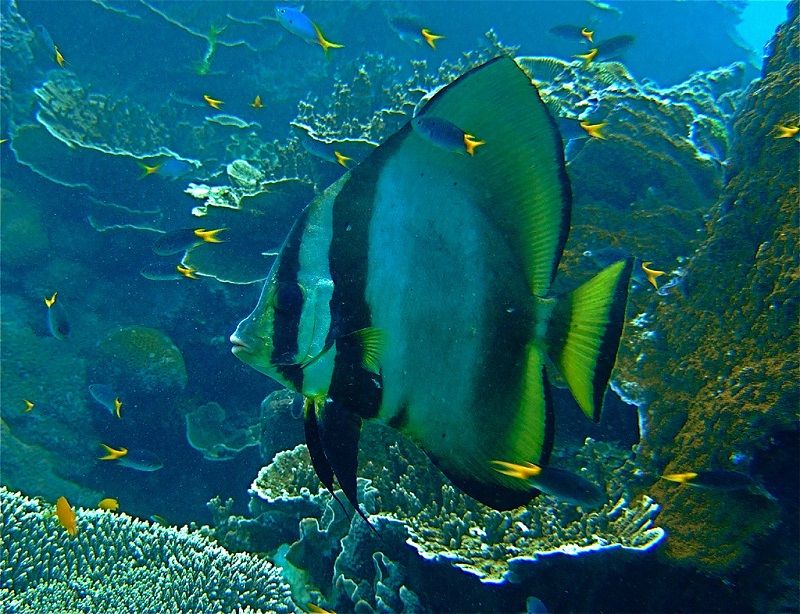Bat fish

- Scientific name: Platax pinnatus
- Common Name: Batfish, Red-faced Batfish, Large-finned Batfish
- Aquarium size: 2,000 liters
- Temperament: Peaceful
- Temperature: 25ºC to 28ºC
- pH: Above 7.8 (Density 1.025)
- Diet: Omnivores
- Length: 45 cm long, 75 cm high
Description
The Bat Fish or Platax pinnatus belongs to the Epiphyde family , also known as Placids.
Platax pinnatus are a very original species of marine fish, which undergo a great transformation in morphology and colors throughout their lives.
Perhaps due to these transformations, the classification of this genus is quite confusing, since the specimens can vary, depending on the marine biotope from which they come.
Morphology
In its natural environment it can measure up to 75 centimeters tall and weigh 25 kilos, in an aquarium it does not reach those dimensions, although it can measure up to 45 centimeters long in its adult state.
Its body is tall and is compressed laterally. In their youthful state, they powerfully attract attention for their shape and for having a very showy livery.

They have very developed and surprisingly high dorsal and anal fins, to grow more longitudinally in their adult stage and adopt a discoidal shape.
Its colors are very striking in the juvenile stage, to be much less showy in the adult stage. When they are young, they are dark brown or black with an orange line that runs around the entire perimeter of their body.
As it grows, you can glimpse some stripes that start out orange.
Already in their adult stage, they are silver with two vertical stripes in black. The first strip is at the level of the eye, and the second on the back of the body, at the height of the pectoral fin, which, like the rest of the fins, shows a yellowish tone at the edge.

Another change they undergo is the muzzle, which lengthens as they grow, and the profile of the head is clearly concave.
No sexual dimorphism is seen between males and females.
Distribution and habitat
These fish are native to the Indian and Pacific Oceans, as well as the Red Sea.
They like coral reefs, where they can be found at depths ranging from 2 meters to 50 meters.
The adult specimens swim alone , and live in the outermost areas of the reef, they only mount groups, when they swim in open water.
However, the young Batfish maintain a more gregarious attitude , they swim in groups and prefer to live in the shallower areas of the reef, and also in the protected mangroves. If they go deeper, they look for caves in which to hide and feel safe.
Aquarium conditions
For the young specimens (which are the ones we usually find for sale), to swim without any problem, we need a good-sized aquarium, between 1,000 and 2,000 liters.
We must bear in mind that to introduce fish to a marine aquarium , it must be mature and have been in operation for at least 6 months, although 8 months are recommended for Batfish.
The pH of the water must be above 7.8, the density at 1.025 and the temperature between 25ºC and 28ºC.
Inside the home, the marine aquarium must imitate its natural habitat, with a large amount of rockery and areas where they can hide, as well as having enough space to swim.
You can add corals, and a substrate of fine sand that mimics the seabed.
Diet
They are omnivores, in nature they basically feed on zooplankton, plants, algae, jellyfish and crustaceans.
In the aquarium it should be fed with pieces of mussel, prawns, shrimp, squid, frozen blood worms… They are very voracious and have a very fast growth.
The problem with these fish is their shyness, and that if they feel attacked they can stop eating.
It is important to control that it does not feel intimidated by other species, if so, we must keep it away from its aggressor, so that it can feed. If not, I could refuse the food and let myself die.
Behavior and compatibility
They are very sociable fish, they do not usually have any kind of problem with other fish , but they are also very shy.
We must find very calm and not aggressive aquarium companions. As I have told you before, if they feel harassed they can stop eating.
Reproduction
In the wild it is known that the male mates with several females, but in captivity their reproduction has not been possible, at the moment there is no data in this regard.
Tips
The Bat Fish is not very demanding with the physical-chemical characteristics of the aquarium, however it is not an easy fish to maintain, due to its special character.
As its reproduction in captivity has not yet been possible, the specimens that we can find for sale come from their natural habitat.
The transition from life in freedom to the aquarium is usually difficult, that is why they are fish indicated only for experienced aquarists.
We also have to take into account the enormous changes that this species has, from its most juvenile state to its adult stage for two reasons, the size it acquires when it grows, the morphological change and its color.








